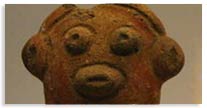Amerindian Heritage
 Telling the story of the indigenous peoples of the Caribbean.
Telling the story of the indigenous peoples of the Caribbean.
Download Entire Kit (PDF) or individual units below.
Lessons at a Glance
Amerindian Migrations
The Amerindian Migrations covers early migratory groups and settlers from the Americas, before their contact with European colonialists. It provides a good overview of the history of Amerindian settlement and their slow transformation from hunter-gatherers to sedentary cultures during the Archaic period.
Lesson: PDF, DOCX /
Handout: PDF, DOCX
Amerindian Foods
Amerindian Foods builds on Amerindian Migrations to delve into the types of foods and agricultural development that marked a major transition from hunter-gatherer cultures to sedentary cultures.
Lesson: PDF, DOCX / Handout 1: PDF, DOCX / Handout 2: PDF, DOCX
Amerindian Tools
Amerindian Tools builds on prior lessons to examine the objects (digging implements, ceramics and stone objects) early settling groups relied on to grow and thrive in their environment.
Lesson: PDF, DOCX / Handout 1: PDF, DOCX / Handout 2: PDF, DOCX
Culture
Culture helps students identify characteristics of a culture, including those not immediately apparent on the surface (using an iceberg metaphor) from observation alone.
Lesson: PDF, DOCX / Handout: PDF
What is Archaeology?
This unit provides an overview of the important role archaeologists play in investigating and preserving our past.
Lesson: PDF, DOCX / Handout: PDF, DOCX
Lesson Formats
Lessons are prepared for 20-40 minutes of teaching time. Most lessons include a pre-visit lesson, a lesson or activity for students to complete during the visit, and a post-visit debriefing and wrap-up activity. Many lessons also contain Extension Activities for secondary students with more advanced learning activities.
Lesson objectives
Each lesson will contain a primary learning objective, and may contain 1-3 sub-learning objectives. Some lessons may have recommended “entry skills” or lessons. Each lesson sidebar also contains useful tie-in themes and topics.
Procedure
Step-by-step instructions for guiding the lessons are included. They may be altered, omitted, or shortened depending on your individual needs. Many of the procedures contain activation/introductory strategies to garner students’ attention before launching into the main content, and reflective activities to help students construct knowledge about the content and connect it to prior knowledge. This ensures successful learning of content.
Debriefing
Each lesson contains a debriefing activity, usually in the form of addressing your class as a large group and discussing the prior activities or museum exhibit(s) that were explored. Debriefing exercises are very important in helping students make important connections of the content with knowledge they already have. These connections help expand their knowledge, skills, and attitudes in order to successfully integrate new material into their framework. We recommend teachers provide scaffolding for their students as they work through important lessons and concepts; provide them with clues, hints, or leading questions that help them arrive at correct conclusions and make important connections.
Adaptations for Struggling Students
We do our best to include additional techniques and tips for students who struggle with material, or who may not have as advanced reading and writing
skills. Typically, this involves pairing the struggling student with a more advanced learner, and having the other learner assist or tutor the student
where appropriate.
We Want Your Feedback
How do these lessons hold up in practice? How are the activities? What works, and what doesn’t? Do you have any recommendations on how to improve these? We would love to hear from you. Please complete our evaluation survey to provide feedback on a unit lesson and make suggestions for improvement. Additionally, you may email the museum at [email protected].
